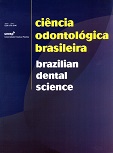Evaluation and development of a bone age assessment method in patients with Down syndrome
DOI:
https://doi.org/10.14295/bds.2012.v15i2.760Palavras-chave:
Down syndrome. Bone development. Cervical vertebrae. Growth. Radiology.Resumo
This study evaluated the applicability of the method developed by Caldas to measure vertebral bone age for Brazilians suffering from Down syndrome. A database comprised of 57 case records of individuals with this syndrome, both male and female, with age ranging between 5 and 18 years, was assessed. These records had lateral cefalometric radiographies and radiographies of hand and wrist, being all obtained on the same date. Also, 48 records of individuals not suffering from Down syndrome were assessed. For the hand and wrist radiographies the Tanner and Whitehouse (TW3) method was used, and bone age was obtained. The Caldas method was employed on the lateral cefalometric radiographies in order to obtain the vertebral bone age. From the information about the bone age, vertebral bone age and chronological age, the Wilcoxon test was used to compare all the ages in pairs. There was a statistically significant difference between the three ages mentioned above for both male and female control group and female Down syndrome group. Therefore, this method was only suitable for Down syndrome male individuals. Based on the results, a formula to obtain the bone age for Down syndrome individuals was developed.
Downloads
Downloads
Arquivos adicionais
Publicado
Como Citar
Edição
Seção
Licença
TRANSFERÊNCIA DE DIREITOS AUTORAIS E DECLARAÇÃO DE RESPONSABILIDADE
Toda a propriedade de direitos autorais do artigo "____________________________________________________________________" é transferido do autor(es) para a CIÊNCIA ODONTOLÓGICA BRASILEIRA, no caso do trabalho ser publicado. O artigo não foi publicado em outro lugar e não foi submetido simultaneamente para publicação em outra revista.
Vimos por meio deste, atestar que trabalho é original e não apresenta dados manipulados, fraude ou plágio. Fizemos contribuição científica significativa para o estudo e estamos cientes dos dados apresentados e de acordo com a versão final do artigo. Assumimos total responsabilidade pelos aspectos éticos do estudo.
Este texto deve ser impresso e assinado por todos os autores. A versão digitalizada deverá ser apresentada como arquivo suplementar durante o processo de submissão.




























